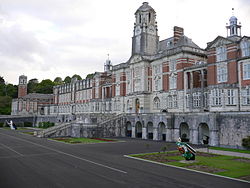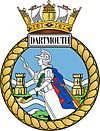- Britannia Royal Naval College
-
Britannia Royal Naval College, Dartmouth 
Active 1863 (HMS Britannia) – Present Country United Kingdom Branch Royal Navy Type Training Role Initial Officer Training Size 300 (approx) Part of Flag Officer Sea Training Ship's Name HMS Dartmouth Nickname BRNC Motto To deliver courageous leaders with the spirit to fight and win Badge 
Anniversaries 1905 - Opening of the current College Commanders Current
commanderCommodore S. P. Williams, Royal Navy Lord High Admiral HM The Queen Flag Officer Sea Training Rear Admiral C. Snow of the British Armed ForcesComponents Surface fleet
Fleet Air Arm
Submarine Service
Royal Naval Reserve
Nursing Service (QARNNS)
Royal Fleet AuxiliaryRoyal Marines Reserve
Special Boat ServiceHistory and future History of the Royal Navy
History of the Royal Marines
Customs and traditions
Future of the Royal NavyShips Current fleet
Current deployments
Historic shipsPersonnel The Admiralty
Senior officers
Uniforms
Officer rank insignia
Ratings rank insigniaRelated civilian agencies of
the Ministry of DefenceRoyal Maritime Auxiliary Service
(now privatised)Britannia Royal Naval College (BRNC) is the initial officer training establishment of the Royal Navy, located on a hill overlooking Dartmouth, Devon, England. While Royal Naval officer training has taken place in the town since 1863, the buildings which are seen today were only finished in 1905, and previous students lived in two wooden hulks moored in the River Dart. Since 1998, BRNC has been the sole centre for Royal Naval officer training.
Contents
History
The training of naval officers at Dartmouth dates from 1863 when the wooden hulk HMS Britannia was moved from Portland and moored in the River Dart.[1] In 1864, after an influx of new recruits, Britannia was supplemented by HMS Hindostan.[2] Prior to this there had been a Royal Naval Academy (later Royal Naval College) at Portsmouth from 1733 to 1837. The original Britannia, was replaced by the Prince of Wales in 1869, which was renamed Britannia.[3] Sir Aston Webb designed the shore-based college at Dartmouth, which was built by Higgs and Hill[4] and practically completed in 1905.[5] The first term of cadets entered at the R.N. College Osborne were transferred to Dartmouth in September 1905.[5]
“ The Britannia training establishment was closed at the same time, the cadets then under instruction being embarked on two cruisers for the purpose of completing their instructions under the old system. The headquarters of the cruisers was established at Bermuda, where suitable arrangements had been made for the convenience of the cadets. The cadets entered in September under the old system, and those entered in January 1906 (the last to be so entered), were received at the Royal Naval College, Dartmouth, where they were instructed, as far as possible, side by side with the cadets transferred from Osborne. ” —Lord Tweedmouth, First Lord of the Admiralty, 26 February 1906[5]
The college was originally known as the Royal Naval College, Dartmouth, and as a Royal Naval shore establishment was later additionally known by the ship name HMS Britannia (there was a battleship called Britannia from 1904 to 1918). The college received its present name (ship name: HMS Dartmouth) in 1953, when the name Britannia was given to the newly-launched royal yacht HMY Britannia. The training ship moored in the River Dart at Sandquay, currently the former Sandown class minehunter, HMS Cromer, continues to bear the name Hindostan.
Cadets originally joined the Royal Naval College, Osborne at the age of 13 for two years before joining Dartmouth, and spent four years there before starting sea training at 17. RNC Osborne closed in 1923, and the entry age was changed to 16 in 1948, and to 17 and 6 months in 1955. Until 1941, Dartmouth was in effect a specialised boarding school, with parents paying fees for tuition and board.
During the Second World War students and staff moved activities to Eaton Hall in Cheshire until the autumn of 1946 after a September 1942 incident involving six Focke-Wulf aircraft released a payload of bombs over the College. Two bombs penetrated the College's main block, causing damage to the quarterdeck and surrounding rooms.[6][7]
The College today
Today, officer cadets, as they are known until passing out from the college, can join between the ages of 18 and 32. While most cadets join BRNC after finishing university, some still join directly from school.[8] All spend between 28 and 49 weeks at the college, depending on specialisation. There is a large contingent of foreign and Commonwealth students. The Royal Fleet Auxiliary sends its officer cadets to BRNC for 7 week initial officer training before they start at a maritime college.
Following the closure of the Royal Naval College, Greenwich in 1998, BRNC is the sole naval college in the United Kingdom.
Entry
To enter as an officer cadet, British entrants must have 180 or more Universities and Colleges Admissions Service UCAS points. Prospective cadets then proceed to the Admiralty Interview Board, where they are tested mentally and physically. Several mental aptitude tests are administered, along with a basic physical fitness test and a medical examination.
Royal cadets
King George V and King George VI were naval cadets at Dartmouth, as were the Duke of Edinburgh, the Prince of Wales and the Duke of York. It is said that the Duke of Edinburgh met the then Princess Elizabeth at Dartmouth.[citation needed] Prince William spent a brief period at the College after leaving Sandhurst as part of his training with all three of Britain's Armed Forces.
Sheikh Mubarak Ali Yousuf Suoud Al-Sabah, a member of the Royal Family of Kuwait, attended the Royal Navy Young Officer Course at Britannia Royal Naval College in 2002.[9][10]
Commanders of the College
Source for list below: Listing compiled by historian Colin Mackie;[11] additional references are given in the list.
- Captain William E. Goodenough: May 1905-August 1907
- Captain Trevylyan D. W. Napier: August 1907-July 1910
- Captain Hugh Evan-Thomas: July 1910-July 1912
- Captain the Hon. Victor A. Stanley: July 1912-? 1914
- Rear-Admiral Trevylyan D. W. Napier: September-December 1914
- Captain Edmond Hyde Parker: ? 1914-February 1915
- Captain Norman C. Palmer: February 1915-May 1916
- Rear-Admiral William G. E. Ruck Keene: May 1916-?
- Captain Eustace la T. Leatham: February1919-February1921
- Captain Francis A. Marten: February1921-January 1923
- Captain the Hon. Herbert Meade: January 1923-February 1926
- Captain Martin E. Dunbar-Nasmith: February 1926-February 1929
- Captain Sidney J. Meyrick: February 1929-December 1931
- Captain Norman A. Wodehouse: December 1931-December 1934
- Captain Reginald V. Holt: December 1934-December 1936
- Captain Frederick H. G. Dalrymple-Hamilton: December 1936-November 1939
- Captain Robert L. B. Cunliffe: December 1939-April 1942
- Captain Edward A. Aylmer: April 1942-December 1943
- Captain Gerald H. Warner: December 1943-?
- Captain Peveril B. R. W. William-Powlett: January 1946-February 1948
- Captain Hugh W. Faulkner: February 1948-August 1949
- Captain Norman V. Dickinson: August 1949-April 1951
- Captain Richard T. White: April 1951-August 1953
- Captain William G. Crawford: August 1953-April 1956
- Captain William J. Munn: April 1956-August 1958
- Captain Frank H. E. Hopkins: August 1958-August 1960
- Captain Horace R. Law: August 1960-December 1961
- Captain W. John Parker: December 1961-September 1963
- Captain John E. L. Martin: September 1963-August 1966
- Captain Ian W. Jamieson: August 1966-April 1968
- Captain David Williams: April 1968-September 1970
- Captain A. Gordon Tait: September 1970-August 1972
- Captain John M. Forbes: August 1972-September 1974
- Captain Michael A. Higgs: September 1974-September 1976
- Captain Paul W. Greening: September 1976-October 1978
- Captain Nicholas J. S. Hunt: October 1978-June 1980
- Captain J. Julian R. Oswald: June 1980-June 1982
- Captain Timothy M. Bevan: June 1982-September 1984
- Captain George M. Tullis: September 1984-1987
- Captain John R. Brigstocke: 1987-1989
- Captain J. Robert Shiffner: 1989-1991
- Captain Richard G. Hastilow: 1991-1993
- Captain Simon Moore: 1993-1995
- Captain Anthony P. Masterton-Smith: 1995-January 1998
- Commodore Roy A. G. Clare: January 1998-1999
- Commodore Mark W. G. Kerr: 1999-2002
- Commodore C. Anthony Johnstone-Burt: 2002-2004
- Commodore Richard J. Ibbotson: 2004-2005
- Commodore Timothy Harris: 2005-April 2007
- Commodore Martin B. Alabaster: April 2007-September 2008
- Commodore Jake K. Moores: September 2008-March 2011
- Commodore Simon P. Williams: March 2011-
Images
See also
- Royal Naval College, Greenwich
- Royal Naval College, Osborne
- The Royal Hospital School
References
- ^ Walker, Charles. Young Gentlemen. p. 39.
- ^ Walker, Charles. Young Gentlemen. p. 40.
- ^ Lambert, Andrew Battleships in Transition, the Creation of the Steam Battlefleet 1815-1860 pages 122, 127-128
- ^ 'General introduction', Survey of London: volume 26: Lambeth: Southern area (1956), pp. 1-17. Date accessed: 27 March 2010.
- ^ a b c Lord Tweedmouth, First Lord's Statement explanatory of Navy Estimates, 1906-7, 26 February 1906, reproduced in The Naval Annual 1906, page 370.
- ^ Jane Harrold and Richard Porter, Dartmouth : Richard Webb, 2005, ISBN 9780953636136
- ^ Article by Jane Harrold and Richard Porter in The Britannia Magazine 2004, Crest Publications, pages 6 - 7
- ^ Royal Navy Sponsorship
- ^ University of Plymouth, Honorary Doctorates September 2010
- ^ This is Plymouth, Sheikh awarded honorary doctorate 25 September 25 2010
- ^ Listing compiled by historian Colin Mackie
External links
The Americas Asia Bangladesh · India · Japan · Lebanon · Pakistan · Singapore · South Korea · Sri Lanka · Thailand · TurkeyEurope Categories:- Educational institutions established in 1863
- Racquets venues
- Education in Devon
- Naval academies
- Training establishments of the Royal Navy
- Military academies of the United Kingdom
- 1863 establishments in the United Kingdom
- Economy of Devon
Wikimedia Foundation. 2010.




